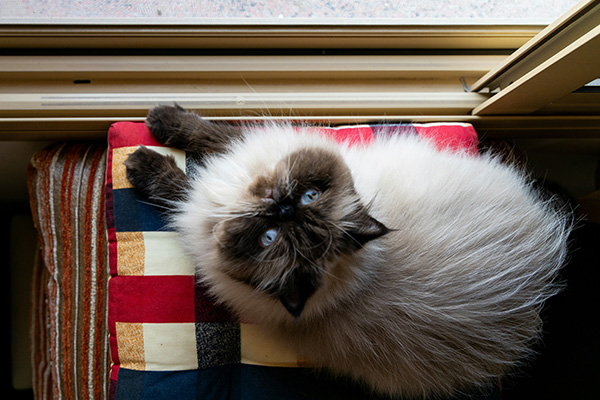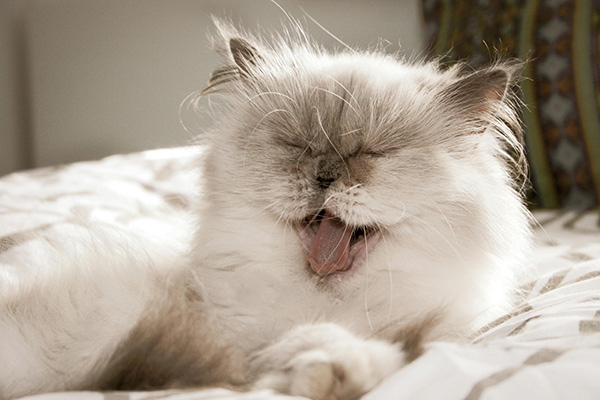With their plush coats, vivid blue eyes, and gentle demeanor, Himalayan cats are undeniably captivating. This elegant breed is a cross between Persians and Siamese, merging the serene, loving temperament of Persians with Siamese cats' spirited, engaging traits. Whether you're drawn to their stunning looks or their gentle companionship, there’s a lot to love—and learn—about this elegant breed.
In this guide, we’ll cover everything you need to know about Himalayan cats, including their origin, personality traits, grooming needs, health considerations, and what it’s like living with one.
Origin
The Himalayan cat is a beautiful blend of two iconic breeds: the Persian and the Siamese. Also known as Himalayan Persian or Colourpoint Persian. In the 1930s, breeders in the United States and the United Kingdom set out to create a cat that combined the luxurious, long coat of the Persian cats with the striking color points and vivid blue eyes of the Siamese.
After years of careful breeding, the Himalayan was officially established as a distinct breed. It gained recognition from various cat associations, including the American Cat Fanciers’ Association (ACFA) in 1957. However, some organizations, such as the International Cat Association (TICA), consider it a variety of Persian rather than a separate breed.
Appearance and Size

The Himalayan cat is a medium to large breed with a sturdy, heavy-boned body. Male Himalayan cats usually weigh around 9 to 14 pounds, whereas females tend to be lighter, typically ranging from 7 to 11 pounds. Their solid frame is complemented by a broad chest, short legs, and a luxuriously full coat that makes them appear even larger. Despite their heavy build, the Himalayas are gentle and graceful in their movements. Full physical maturity can take up to two years, with males often developing a slightly more muscular appearance compared to the more refined build of females.
Life Expectancy
Himalayan cats generally live between 9 and 15 years. With the right care, such as a nutritious diet, consistent vet visits, proper grooming, and attention to their unique health requirements, they can enjoy life well into their mid-teens.
Personality
The Himalayan kitty is known for its sweet, calm, and affectionate personality. They are intelligent and observant but prefer a laid-back lifestyle rather than constant mental challenges. Their energy level is low to moderate—they enjoy playful moments but are happiest lounging in cozy spots.
Himalayans are generally quiet cats, communicating with soft, gentle meows rather than loud vocalizations. They are highly sociable with their family members, forming strong bonds and often following their favorite people from room to room. Initially, they might be a bit reserved around unfamiliar people, but they typically become friendly once they feel comfortable. Confident in familiar surroundings, they thrive in stable, predictable environments. These affectionate cats love being petted, cuddled, and included in family life, often seeking laps and gentle attention. They make excellent companions for anyone who values a gentle, affectionate cat that doesn't require constant stimulation or high-energy play.
Himalayan cats possess a quiet intelligence and a curious nature that’s sometimes overlooked because of their laid-back attitude. Though not as energetic as some other breeds, they still need mental stimulation and engaging activities to stay happy. Without sufficient enrichment, they may become bored, potentially leading to overeating, lethargy, or unwanted behaviors such as scratching furniture or vocalizing excessively in search of attention.
To keep their minds sharp and their bodies active, interactive toys such as feather wands, laser pointers, and motion-activated gadgets are great options. Puzzle feeders and treat-dispensing toys encourage them to think and work for rewards, satisfying their natural instinct to hunt. Short but regular play sessions with their owners help build trust and provide physical activity without overwhelming them.
Switching out toys and occasionally introducing new ones helps keep their environment engaging and mentally stimulating. Even calm cats like Himalayans need daily play and challenges to stay happy and mentally fit.
Temperament
Himalayan cats are cherished for their loving, gentle, and calm personalities, making them ideal companions for many households. They usually coexist peacefully with other pets, including fellow felines and well-mannered dogs. Thanks to their laid-back disposition, they can adapt well to multi-pet environments, particularly when introductions are done gradually and with care.
Himalayans tend to be good with children, particularly those who are calm and know how to treat animals with kindness and respect. They enjoy quiet playtime and snuggling but are not overly demanding of attention. Himalayan cats might initially be reserved around new people, often choosing to watch quietly from afar before gradually opening up. Once they feel safe, their loving and devoted nature shines through. They thrive best in calm, nurturing settings where they feel protected and cherished. While playful, they are not overly energetic, preferring calm interactions over roughhousing. Their calm and affectionate nature makes them perfect companions for families, individuals, and seniors.
Diet and Nutrition
The Himalayan cat thrives on a high-quality, balanced diet rich in protein to support its muscular build and maintain its luxurious coat. Opt for cat foods prioritizing real meat as the main ingredient and steer clear of fillers such as corn or soy. Given their relaxed nature, Himalayans can be susceptible to weight gain, so monitoring portion sizes is essential. Himalayans are long-haired cats and may benefit from hairball-control formulas, as their long fur increases the risk of hairballs. Always provide freshwater, and offering wet food occasionally can help support their hydration. Regular monitoring of their weight and body condition is key to long-term health.
Adaptability

Himalayan cats are moderately adaptable but thrive best in calm, stable environments. They adjust well to apartment living or larger homes, as long as they have cozy spaces to relax and observe their surroundings. Loud, chaotic households or frequent changes can cause stress for a Himalayan, as they prefer a predictable and peaceful atmosphere. They can comfortably coexist with other pets and children with proper introductions and time to adjust. However, they are sensitive by nature and may withdraw if overwhelmed. With patience, gentle handling, and a consistent routine, Himalayans settle in beautifully and become devoted, affectionate companions.
Trainability
The Himalayan cat is intelligent but has a calm, sometimes stubborn nature, which can make trainability a slow but rewarding process. They can learn basic commands like coming when called or using a scratching post, especially when motivated with treats and gentle praise. Their affectionate bond with their owners helps them respond well to positive reinforcement; however, their laid-back temperament means they may not be as eager to perform tricks or engage in intensive training sessions as compared to more active breeds. Consistency, patience, and short, low-pressure sessions are key to successfully training a Himalayan cat.
Shedding
Himalayan cats are heavy shedders due to their long, thick double coats. They shed moderately year-round, with more intense shedding during the spring and fall as they switch between seasonal coats.
Grooming
Due to their long, dense, and silky coat, the Himalayan cat's grooming needs are quite intensive. Brushing your dog's coat daily is highly recommended to prevent tangles and mats, which can develop rapidly, especially around the neck, behind the ears, and under the legs. Daily grooming not only keeps the Himalayan coat beautiful but also reduces shedding and the risk of hairballs. Bathing a Himalayan every few months helps maintain the cleanliness and softness of their fur, as their thick coat can trap dirt and oils.
Along with maintaining their coat, regular nail trimming, ear cleaning, and dental care are vital components of their grooming routine. Their prominent, expressive eyes are susceptible to tear staining, so gently wiping them with a damp cloth daily can help reduce staining and prevent irritation. Regular grooming is crucial to keeping a Himalayan healthy, comfortable, and looking its finest.
Cost
When bought from a reputable breeder, Himalayan cats cost $800 to $1,500. The cost can fluctuate depending on factors such as pedigree, the breeder's reputation, coat color, and whether the cat is intended for show or as a pet. Himalayan kittens from champion bloodlines or with rare color points can cost $2,000 or more.
Potential Health Problems

Polycystic Kidney Disease (PKD)
Polycystic Kidney Disease (PKD) is a genetic condition commonly found in Himalayan and Persian breeds. It causes numerous fluid-filled cysts to form in the kidneys, slowly impairing kidney function over time. Symptoms usually don’t emerge until the cat reaches middle age and may include excessive thirst, frequent urination, weight loss, and lethargy. PKD is progressive and can eventually lead to kidney failure. Responsible breeders now screen breeding cats using ultrasound or genetic tests to prevent passing the condition on. Early diagnosis can help manage the disease with diet modifications and supportive veterinary care.
Brachycephalic Respiratory Syndrome
Himalayans are a brachycephalic (flat-faced) breed, which predisposes them to respiratory difficulties. Their shortened nasal passages can cause noisy breathing, snoring, exercise intolerance, and an increased risk of overheating, particularly in hot or humid weather. In severe cases, they may struggle with chronic breathing problems that require surgical intervention. Owners should keep them indoors during hot weather, minimize stress, and closely monitor their breathing. Maintaining a healthy weight is also essential to prevent unnecessary strain on the respiratory system.
Dental Issues
Because of their shortened jaw and facial structure, Himalayans often have crowded or misaligned teeth. This can trap food debris and bacteria, contributing to plaque formation, gingivitis, and eventually periodontal disease. Dental infections can cause pain, and if bacteria enter the bloodstream, they may also affect critical organs, such as the heart and kidneys. Daily tooth brushing, dental chews, and regular veterinary dental cleanings are critical to preventing serious oral health problems.
Eye Problems
Himalayan cats are prone to excessive tear production due to their distinctive facial structure, which can lead to tear staining around the eyes. Constant moisture around the eyes can lead to skin irritation and heighten the risk of bacterial infections. Additionally, they are vulnerable to more severe eye issues like cherry eye (tear gland prolapse) and progressive retinal atrophy (PRA), a degenerative condition that can cause blindness. Gently wiping the eyes with a soft, damp cloth daily can help manage staining and minimize infection risk. Routine eye exams are also essential for the early identification of more serious conditions.
Obesity
Himalayans have a naturally calm, laid-back temperament, which makes them less active than many other breeds. Combined with their love for lounging, they are at high risk for obesity if their food intake isn’t carefully managed. Carrying excess weight can contribute to various health problems, such as diabetes, arthritis, heart disease, and respiratory issues. Owners should feed them controlled portions, avoid too many treats, and encourage moderate daily play to keep them fit and healthy.
Ringworm and Skin Issues
Their thick, luxurious coat, although stunning, demands consistent care. When their fur becomes matted or stays damp, it can provide a perfect setting for fungal infections, such as ringworm. Ringworm presents as circular patches of hair loss, scaling skin, and itchiness. Himalayans are also prone to skin irritations and dermatitis if proper grooming is neglected. Consistent brushing, routine skin checks, and keeping a clean environment are crucial for preventing these issues.
Heart Disease (Hypertrophic Cardiomyopathy - HCM)
While rarer in Himalayan cats compared to some other breeds, they can still develop Hypertrophic Cardiomyopathy (HCM), which causes the heart muscle to thicken, impairing the heart’s ability to pump blood efficiently. If left undiagnosed or unmanaged, HCM can result in heart failure, blood clots, or even sudden death. Symptoms include labored breathing, lethargy, fainting, and sudden weakness in the back legs. Routine veterinary checkups, including heart scans when advised, can help detect this condition early.
